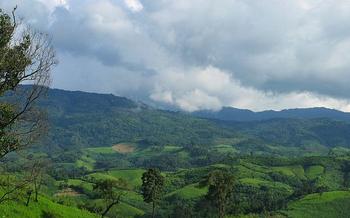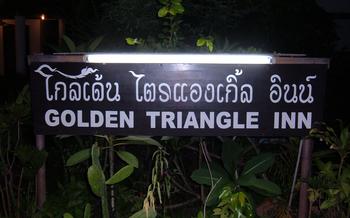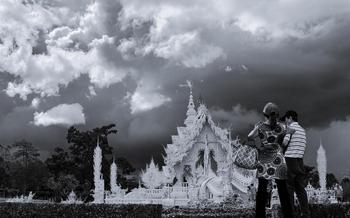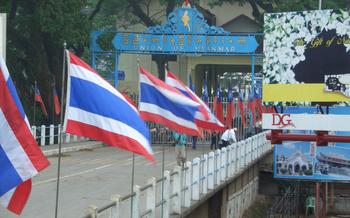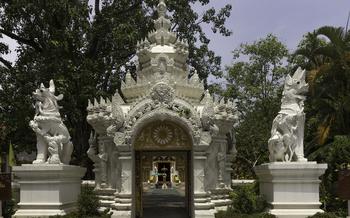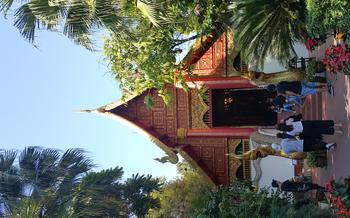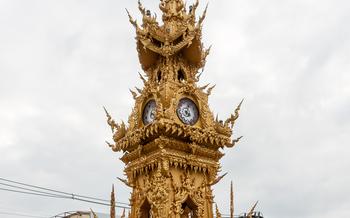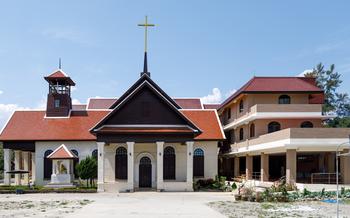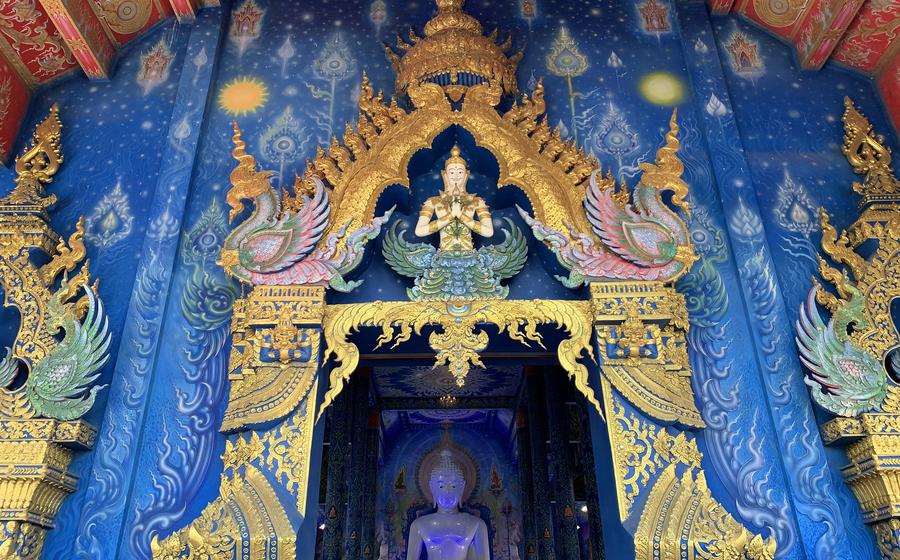
Wat Rong Suea Ten (The Blue Temple)
- Wat Rong Suea Ten (The Blue Temple)
- Getting to the Blue Temple
- Exploring the Temple Grounds
- The Blue Temple's Unique Features
- The Temple's Spiritual Significance
- The Legend of the Blue Temple
- Myths and Legends Associated with the Blue Color
- Connection to the Lanna Kingdom's Heritage
- Visiting Tips and Etiquette
- The Temple's Surrounding Area
- Guided Tours to the Blue Temple
- Combining the Blue Temple with Other Attractions
- History and Background of Chiang Rai
- Accommodation Options in Chiang Rai
- Local Cuisine and Dining Options
- Cultural Activities and Festivals
- Insider Tip
Wat Rong Suea Ten (The Blue Temple)
The Blue Temple, also known as Wat Rong Suea Ten, is a stunning Buddhist temple located in Chiang Rai, Thailand. It was built in 2005 by a local artist named Chalermchai Kositpipat and has quickly become one of the most popular tourist attractions in the region. The temple's striking blue exterior and intricate details make it a must-see for anyone visiting Chiang Rai.
Architectural Style and Unique Features The Blue Temple is a unique blend of traditional Thai and modern architecture. The temple's exterior is adorned with vibrant blue tiles, which are believed to represent the purity of Buddhism. The interior of the temple is equally impressive, with intricate murals, sculptures, and carvings depicting scenes from Buddhist mythology.
Significance and Cultural Importance The Blue Temple is not only a popular tourist destination but also a significant religious site for Thai people. The temple is home to a number of sacred Buddha images, and many locals visit the temple to pray and make offerings. The temple also plays an important role in the local community, hosting events and festivals throughout the year.
Visiting Hours and Entrance Fees The Blue Temple is open to visitors daily from 8:00 am to 5:00 pm. There is no entrance fee to visit the temple, but donations are welcome. Visitors are encouraged to dress respectfully when visiting the temple, and to remove their shoes before entering the main prayer hall.
Getting to the Blue Temple
The Blue Temple, situated in the city of Chiang Rai, offers a captivating escape from the city's hustle and bustle. Nestled in the countryside's serenity, it demands a journey of roughly 13 kilometers from Chiang Rai's city center. While the distance may seem substantial, the journey is a breeze, taking approximately 30 minutes by car or taxi.
For those seeking a leisurely experience, songthaews, the iconic red pickup trucks that serve as local transport, provide a budget-friendly option. Simply hop aboard one heading towards Mae Sai and request a stop at the Blue Temple. The fare is typically around 20-30 baht, ensuring an economical and immersive experience.
Exploring the Temple Grounds
The Blue Temple's layout and design are a testament to the creativity and artistry of its creator, Chalermchai Kositpipat. The temple complex features several structures, each adorned with intricate details and unique architectural elements. Visitors are immediately drawn to the main temple, known as the Ubosot, with its striking blue exterior and towering spires. Inside, the walls are adorned with exquisite murals depicting scenes from Buddhist mythology and the life of the Buddha.
Surrounding the Ubosot are several other structures, including the ordination hall, the bell tower, and the meditation hall. Each structure serves a specific purpose in the temple's daily rituals and ceremonies. Visitors can explore the grounds, admiring the intricate carvings, colorful mosaics, and statues that adorn every corner.
A comprehensive visit to the Blue Temple requires at least an hour to fully appreciate its grandeur and unique features. It's advisable to set aside ample time to wander through the temple complex, soak in the serene atmosphere, and capture the temple's beauty from different angles.
When visiting the Blue Temple, it's important to dress respectfully and observe proper temple etiquette. Visitors should wear modest clothing, covering their shoulders and knees. Shoes must be removed before entering the temple buildings, and it's customary to bow or wai in front of the Buddha images as a sign of respect.
The Blue Temple's Unique Features
The Blue Temple stands out with its striking cobalt blue exterior, a color that symbolizes royalty, purity, and spirituality in Thai culture. Every surface of the temple, from the walls and roofs to the intricate carvings and sculptures, is adorned in vibrant blue, creating a captivating visual spectacle.
The temple's ornate decorations and intricate details further enhance its allure. The facades are adorned with exquisite carvings depicting mythical creatures, celestial beings, and scenes from Buddhist mythology. The gables, columns, and doorways showcase a fusion of traditional Lanna and modern artistic styles, resulting in a unique and harmonious blend.
Inside the temple, visitors are greeted by an awe-inspiring sight: a massive golden Buddha statue seated in a serene and meditative posture. The altar area is adorned with colorful murals and paintings depicting the life of Buddha and significant events from Buddhist scriptures. Each mural tells a story, inviting visitors to delve deeper into the temple's spiritual significance.
The Blue Temple's artistic beauty and unique features make it a popular subject for photography. The striking blue exterior against the backdrop of the surrounding greenery creates Instagram-worthy shots that are sure to captivate your followers. Don't forget to capture the intricate details, sculptures, and murals that add to the temple's charm and allure.
The Temple's Spiritual Significance
Wat Rong Suea Ten is not just a stunning architectural marvel but also holds deep spiritual significance for the local community and visitors alike. As a Buddhist temple, it serves as a place of worship, meditation, and spiritual reflection. Devotees come here to pay homage to Buddha, offer prayers, and seek blessings. The temple's serene atmosphere and intricate iconography create a conducive environment for contemplation and introspection.
Visitors can witness various Buddhist rituals and practices taking place within the temple grounds. Monks perform daily chanting ceremonies, and laypeople often come to make offerings of flowers, incense, and candles. There are also opportunities for visitors to participate in meditation sessions and learn more about the teachings of Buddhism. The temple's spiritual essence is palpable, making it a sacred space for both locals and tourists to connect with their inner selves and find peace and tranquility.
The Legend of the Blue Temple
The Blue Temple is shrouded in local folklore and legends that add to its mystique. According to one popular tale, the temple's founder, Ajarn Chalermchai Kositpipat, was inspired to build the temple after a dream. In the dream, a deity appeared to him and instructed him to construct a blue temple that would be a symbol of peace and tranquility.
Another legend associated with the temple is the story of the blue color. It is said that Ajarn Chalermchai chose blue as the primary color for the temple to represent the purity of the sky and the ocean. The blue color is also believed to have calming and soothing effects, which aligns with the temple's intended purpose as a place of meditation and spiritual reflection.
Myths and Legends Associated with the Blue Color
The blue color of the temple has given rise to various myths and legends. One myth suggests that the blue color is a representation of the Buddha's aura, which is often depicted as blue in Buddhist iconography. Another legend tells of a magical blue lotus flower that bloomed on the temple grounds, inspiring Ajarn Chalermchai to incorporate the blue color into the temple's design.
Connection to the Lanna Kingdom's Heritage
The Blue Temple's architectural style and design are deeply rooted in the heritage of the Lanna Kingdom, which ruled over Northern Thailand for several centuries. The Lanna Kingdom was known for its unique blend of Buddhist and Hindu influences, which can be seen in the temple's intricate carvings, sculptures, and murals. The Blue Temple serves as a testament to the rich cultural legacy of the Lanna Kingdom and its enduring influence on the region's art and architecture.
Visiting Tips and Etiquette
Respect the sacredness of the temple by dressing appropriately and behaving respectfully.
- Dress modestly with covered shoulders and knees.
- Remove your shoes before entering any of the temple buildings.
- Be mindful of your voice level and avoid talking loudly.
- Refrain from pointing your feet towards Buddha images, as it is considered disrespectful.
- Ask permission before taking photos of people or sacred objects.
- Observe the local customs and practices, and be respectful of the temple's religious significance.
The Temple's Surrounding Area
The Blue Temple is situated in a vibrant and culturally rich neighborhood, offering visitors a variety of attractions and activities beyond the temple grounds. Just a short walk away, you'll find the lively Mae Sai Market, a bustling hub of local vendors selling everything from fresh produce to handmade crafts. Immerse yourself in the vibrant atmosphere as you browse the stalls, haggle for the best prices, and savor the delicious street food delicacies.
For those seeking a more tranquil experience, the serene Mae Fah Luang Garden is a beautiful botanical sanctuary located a few kilometers from the temple. Stroll through the lush gardens, admire the vibrant flowers, and take in the breathtaking views of the surrounding mountains. The garden also features a museum dedicated to the late Princess Srinagarindra, mother of the beloved King Bhumibol Adulyadej, showcasing her contributions to Thailand's agriculture and rural development.
To delve deeper into the history and culture of the region, visit the nearby Chiang Rai National Museum. This museum houses a collection of artifacts and exhibits that chronicle the fascinating history of Chiang Rai, from its ancient origins to its role in the Lanna Kingdom. Learn about the region's diverse ethnic groups, traditional customs, and the significance of Buddhism in shaping the local culture.
If you're looking to extend your stay in the area, there are several accommodation options within easy reach of the Blue Temple. From cozy guesthouses and homestays to luxurious resorts, there's something to suit every budget and preference. Whether you prefer to be in the heart of the action or surrounded by tranquil nature, you'll find a place to rest and rejuvenate after your temple visit.
Guided Tours to the Blue Temple
Booking a guided tour to the Blue Temple can significantly enhance your visit by providing in-depth insights, historical context, and cultural understanding. Professional tour guides offer a wealth of knowledge about the temple's history, architecture, and spiritual significance. They can point out hidden details, explain the symbolism behind the murals and sculptures, and share local legends and folklore associated with the temple.
Various tour options are available to cater to different preferences and budgets. Some tours focus solely on the Blue Temple, while others combine it with visits to other nearby attractions, such as the White Temple, the Black House, or the Chiang Rai Clock Tower. Itineraries may include guided walks through the temple grounds, explanations of Buddhist beliefs and practices, and opportunities to interact with local monks or community members.
The cost of guided tours varies depending on the duration, inclusions, and group size. Generally, a half-day tour to the Blue Temple starts from around 20 USD per person, while full-day tours that combine multiple attractions can range from 40 to 60 USD per person.
When booking a guided tour, it's important to choose a reputable and experienced tour operator. Look for companies that have received positive reviews from previous customers and that provide clear information about their itineraries, inclusions, and cancellation policies.
Combining the Blue Temple with Other Attractions
The Blue Temple is often combined with other attractions in Chiang Rai as part of a day trip or multi-day tour. Popular nearby destinations include the White Temple (Wat Rong Khun), the Black House (Baan Dam), and the Golden Triangle. The White Temple, with its unique and striking architecture, is a must-see for any visitor to Chiang Rai. The Black House, with its dark and mysterious atmosphere, is a fascinating place to explore. The Golden Triangle, where the borders of Thailand, Myanmar, and Laos meet, is a popular destination for boat tours and visits to hill tribe villages.
Day trip itineraries from Chiang Rai typically include visits to the Blue Temple, the White Temple, and the Black House. These tours often start in the morning and return to Chiang Rai in the evening. For those with more time, multi-day tours are available that explore the region in greater depth. These tours may include visits to other temples, historical sites, and natural attractions in Chiang Rai and the surrounding area.
History and Background of Chiang Rai
Chiang Rai, a city nestled in the northernmost reaches of Thailand, boasts a rich and storied past that has shaped its unique cultural identity. Its history dates back to the 13th century when it served as the capital of the Lanna Kingdom, a powerful kingdom that ruled over much of northern Thailand and parts of Laos and Myanmar. During this time, Chiang Rai flourished as a center of trade and commerce, attracting merchants and travelers from across the region. Its strategic location along the ancient trade routes that connected China to Southeast Asia further contributed to its prosperity.
Chiang Rai's cultural heritage is deeply intertwined with the Lanna Kingdom and its distinctive traditions and customs. The city is renowned for its numerous temples and historical sites, many of which date back to the Lanna period. These architectural marvels, with their intricate designs and stunning murals, offer a glimpse into the artistry and craftsmanship of the Lanna people.
Throughout history, Chiang Rai has played a significant role in the political and cultural landscape of Northern Thailand. It has witnessed wars, conquests, and the rise and fall of kingdoms, leaving behind a legacy of historical landmarks that tell the story of its past. Today, Chiang Rai stands as a vibrant and modern city that retains its unique cultural identity, a testament to its rich history and enduring spirit.
Accommodation Options in Chiang Rai
Chiang Rai offers a diverse range of accommodation options to suit every traveler's budget and preferences. From luxurious hotels and boutique guesthouses to budget-friendly hostels and homestays, there's something for everyone in this vibrant city.
For those seeking a touch of luxury, several upscale hotels offer stunning views of the city and surrounding mountains. These hotels often feature modern amenities, such as rooftop pools, spas, and fitness centers.
Boutique guesthouses provide a more intimate and personalized experience, often with unique designs and local touches. These charming accommodations often offer a glimpse into the city's rich cultural heritage.
Budget travelers can find a range of affordable hostels and guesthouses catering to backpackers and budget-conscious travelers. These hostels often offer shared dormitory rooms and basic amenities, but they provide a great opportunity to meet fellow travelers and share experiences.
For a truly unique experience, consider staying in a homestay. These homestays offer a chance to immerse yourself in the local culture and way of life, as you live with a local family and experience their daily routines.
No matter your budget or preferences, Chiang Rai has an array of accommodation options to ensure a comfortable and memorable stay.
Local Cuisine and Dining Options
Chiang Rai's culinary scene is a vibrant tapestry of flavors, offering a delectable array of dishes that tantalize the taste buds. Visitors can embark on a gastronomic journey, savoring the region's signature dishes and local specialties. Khao Soi, a rich and creamy coconut curry noodle soup, is a must-try, known for its harmonious blend of spices and textures. Sai Ua, a succulent grilled sausage infused with herbs and spices, is another local favorite, bursting with aromatic flavors.
For a taste of street food heaven, head to the bustling night markets, where vendors dish up an array of delectable treats. From Pad Thai, the ubiquitous stir-fried rice noodles, to Som Tum, a spicy green papaya salad, there's something to satisfy every palate. Don't miss the Khao Neeo Mamuang, sweet sticky rice with ripe mango, a classic Thai dessert that's both refreshing and indulgent.
If you're a culinary enthusiast, consider taking a cooking class to learn the art of Thai cuisine. These classes offer hands-on experience, teaching you how to prepare traditional dishes using fresh, local ingredients. Whether you're a novice or an experienced cook, you'll leave with a newfound appreciation for Thai gastronomy.
For those with dietary restrictions, Chiang Rai offers a variety of vegetarian and vegan options. Many restaurants cater to plant-based diets, serving up delicious and nutritious dishes that showcase the region's culinary diversity. From tofu curries to vegetable stir-fries, there are plenty of options to satisfy your cravings.
So, embrace your inner foodie and dive into the culinary delights of Chiang Rai. From street food stalls to fine dining establishments, this vibrant city offers an unforgettable gastronomic experience that will leave your taste buds dancing.
Cultural Activities and Festivals
Cultural activities and festivals in Chiang Rai offer a vibrant and immersive experience for visitors. The city hosts a variety of traditional performances, cultural shows, and annual events that showcase the rich heritage and traditions of the region. Visitors can witness mesmerizing Thai dance performances, intricate music concerts, and awe-inspiring traditional ceremonies.
The Chiang Rai Flower Festival, held annually in February, is a must-see event that celebrates the city's beautiful flora. The streets come alive with colorful flower displays, vibrant parades, and cultural performances. Visitors can marvel at the stunning floral creations and enjoy the festive atmosphere that fills the city during this time.
Temples fairs and markets, known as "lae," are another highlight of Chiang Rai's cultural scene. These lively gatherings, often held on temple grounds, offer a unique blend of spirituality, community, and commerce. Visitors can explore stalls selling local handicrafts, taste delicious Thai street food, and witness traditional rituals and performances.
For those interested in experiencing the diverse cultures of the region, visiting hill tribe villages is a rewarding experience. Just outside of Chiang Rai, visitors can interact with ethnic minority groups such as the Karen, Akha, and Hmong, who have preserved their unique customs, traditions, and way of life. From colorful costumes and intricate textiles to traditional music and dance, these encounters offer a glimpse into the rich cultural diversity of Northern Thailand.
Insider Tip
-
Hidden gems and lesser-known attractions: Explore the nearby Mae Fah Luang Art and Cultural Park, showcasing stunning gardens, artworks, and a museum dedicated to the late Princess Mother. Don't miss the unique Wat Huay Pla Kung, a temple adorned with thousands of colorful ceramic fish scales.
-
Off-the-beaten-path experiences: Take a scenic bike ride or hike through the lush countryside surrounding Chiang Rai, discovering hidden temples, waterfalls, and local villages. Visit the White Temple (Wat Rong Khun) in nearby Chiang Rai, an unconventional and visually striking contemporary temple.
-
Tips for avoiding crowds and tourist traps: To beat the crowds at the Blue Temple, aim to visit early in the morning or late in the afternoon. Explore lesser-known temples in the surrounding area, such as Wat Phra That Doi Chom Thong or Wat Tham Seua, which offer equally impressive architecture and cultural significance.
-
Local customs and cultural etiquette: Remember to dress respectfully when visiting temples, covering your shoulders and knees. Remove your shoes before entering temple grounds, and maintain a quiet and respectful demeanor. Learn a few basic Thai phrases to interact with locals, showing appreciation for their culture and hospitality.


